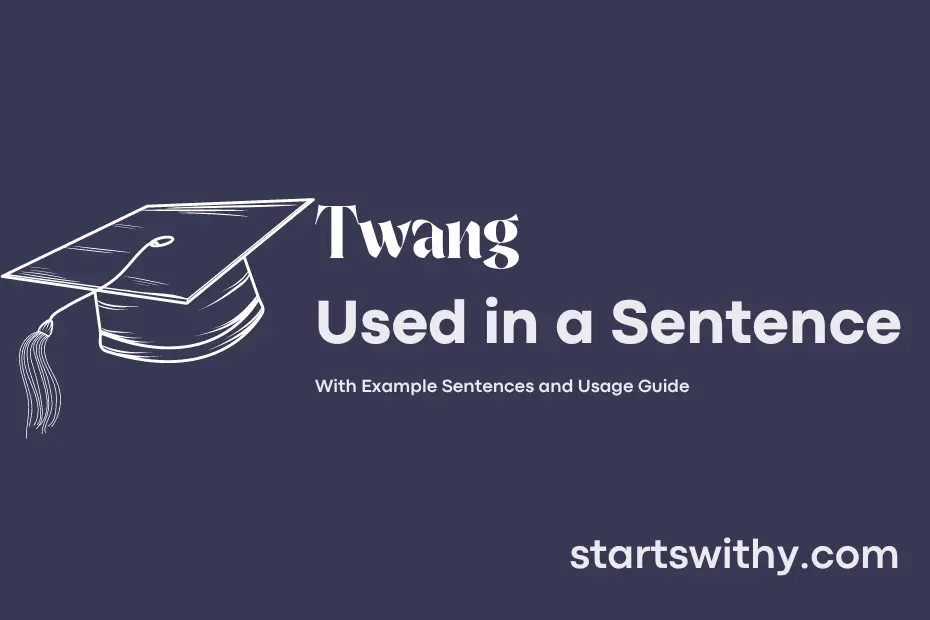Have you ever heard someone speak with a distinctive “twang” in their voice? This unique sound is often characterized by a nasal quality and a slight drawl, giving speech a particular resonance.
A “twang” in speech can vary in intensity and can be influenced by regional accents, cultural background, and individual vocal characteristics. Whether it’s a subtle hint of a twang or a more pronounced feature, this vocal quality adds a distinct flavor to the speaker’s words.
7 Examples Of Twang Used In a Sentence For Kids
- Twang the strings on the guitar to make music.
- The cowboy’s voice had a funny twang.
- I heard a loud twang when the rubber band broke.
- Use a spoon to twang the glass and hear the sound.
- The twangy sound of the sitar filled the room.
- The twang of the spring made me jump.
- Let’s make a twang sound with our vocal cords!
14 Sentences with Twang Examples
- Have you ever played the guitar and felt the twang of the strings?
- The professor’s accent had a distinct Southern twang that made it hard to understand.
- When the bowling ball hit the pins, there was a satisfying twang sound.
- As she pulled back the elastic on her slingshot, she could hear the familiar twang.
- The old gate made a loud twang as it swung open.
- The highlight of the music performance was the guitarist’s impressive twang.
- The banjo player added a unique twang to the folk music concert.
- She adjusted the tension on her bow, ready for the satisfying twang as she released the arrow.
- The springs on the mattress made a loud twang as he sat down on the bed.
- The sound of the sitar’s twang filled the room during the cultural night event.
- The rusty gate made a high-pitched twang as it closed behind him.
- He plucked the strings of his ukulele, producing a cheerful twang.
- The twang of the rubber band hitting his arm caused him to yelp in surprise.
- Amidst the chaos of the college festival, the sound of the twang of the DJ’s turntable was a welcome distraction.
How To Use Twang in Sentences?
To use Twang in a sentence, simply follow these steps:
- Identify the context: Twang typically refers to a sharp, vibrating sound, often produced by a musical instrument like a guitar or a person’s voice.
Example: “The guitarist added a twang to the melody with his skilled playing.”
- Choose the appropriate form: The word twang can be used as a noun or a verb. As a noun, it refers to the sound itself. As a verb, it describes the action of producing that sound.
Example as a noun: “The bowstring’s twang echoed through the forest.”
Example as a verb: “She twanged the strings of the banjo, creating a lively rhythm.”
- Be descriptive: When using twang in a sentence, try to provide additional context to help paint a vivid picture for the reader or listener.
Example: “The old door creaked with a distinct twang, alerting us to someone’s presence.”
- Practice makes perfect: The best way to become comfortable and confident in using twang in sentences is through practice. Try incorporating it into your writing or conversations to become more familiar with its usage.
Remember to have fun experimenting with twang in your sentences and enjoy the creative process of incorporating this unique word into your communication!
Conclusion
In summary, sentences with a twang often exhibit a distinct regional or cultural accent. The twang can be characterized by a nasal tone, drawn-out vowel sounds, and a unique cadence, giving the speaker’s voice a noticeable and sometimes musical quality. This style of speech is commonly associated with Southern American dialects or specific regions within the United States.
Sentences with a twang can add character and authenticity to storytelling, creating a sense of place and enhancing the overall communication. Whether used in fiction writing, dialogue, or everyday conversation, sentences with a twang can bring charm and vividness to language, making the speaker’s voice memorable and engaging.



